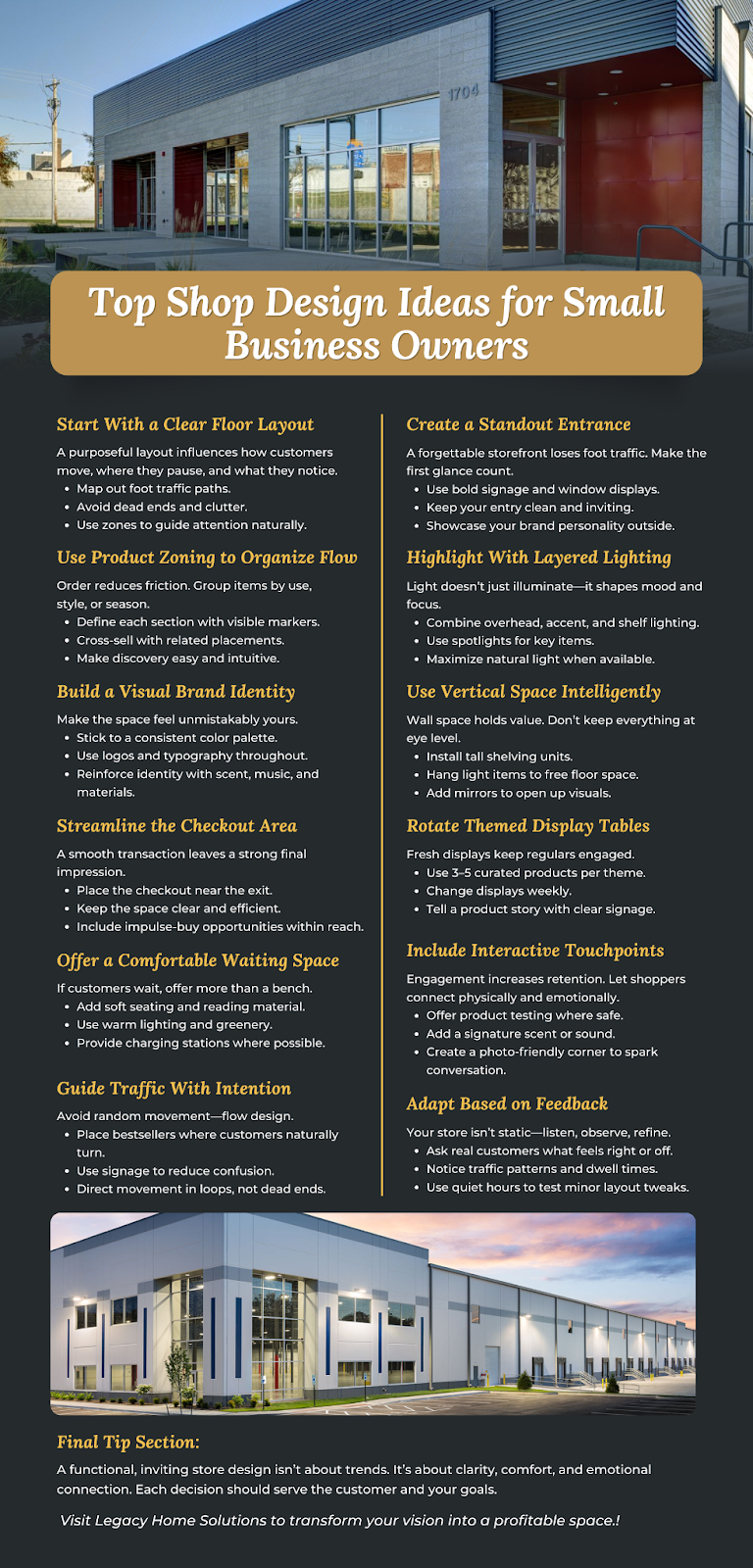A few years ago, a local boutique owner put everything into opening her first shop. She had a strong product line and passion, but foot traffic was slow. The layout was confusing, the entrance lacked appeal, and the interior didn’t match her brand.
Once she updated her design using thoughtful layout and shop design ideas, her business picked up. Customers started noticing her storefront, and once inside, they stayed longer and bought more. The right environment made the difference.
If you’re in the process of opening a store or improving one, these 12 ranked ideas can help you create a space that works for both your business and your customers.

1. Plan a Clear, Functional Floor Layout
Why it’s #1: Everything begins with your layout. The best floor plan improves customer experience and sets the tone for all other elements.
Start with a simple drawing of your space. Identify entry points, focal zones, and logical walking paths. A well-planned layout reduces confusion and increases the chance of a sale. This is where strong commercial shop layout ideas come into play—they help guide customer movement and maximize product visibility.
Tips to improve layout:
- Create a clear path from the entrance to the checkout.
- Avoid clutter and leave enough room to move comfortably.
- Use rugs or furniture to define zones.
- Walk through your space as a customer would—what do they see first?
2. Build an Inviting Storefront Entrance

Why it’s #2: The entrance decides whether someone steps inside. If it’s confusing or unappealing, people walk past—even if they’re interested.
Make sure your storefront is clean, simple, and branded. First impressions matter.
Make your entrance stand out with:
- Large signage that’s easy to read from a distance.
- A tidy glass window with highlighted items.
- A display table that introduces your style or seasonal theme.
- Lighting that draws attention at night or in low-light conditions.
3. Organize with Product Zones
Why it’s #3: Zoning helps customers quickly find what they need and encourages browsing. A messy store causes frustration and lost sales.
Divide your space into clear product areas based on category or purpose.
How to zone effectively:
- Use shelves or racks to separate categories.
- Place related products together to boost cross-selling.
- Label zones with clean, easy-to-read signage.
- Position higher-demand items in the middle zone for visibility.
4. Design with Lighting That Highlights Your Best
Why it’s #4: Lighting affects how people feel and what they notice. The right lighting can increase product interest and make a store feel more welcoming.
Use a combination of general, accent, and display lighting to shape the mood.
Try these lighting ideas:
- Spotlights on new arrivals or bestsellers.
- Warm lighting for cozy areas (like lounges or reading spots).
- LED strips under shelves for a modern detail.
- Natural light, whenever possible—it always adds appeal.
5. Focus on a Branded Visual Identity
Why it’s #5: A strong brand identity builds trust. Consistent color, typography, and decor help customers remember your store and feel comfortable buying from you.
Everything from signage to shelf labels should feel like it’s part of the same family.
Build your brand in-store by:
- Picking 2–3 core colors and repeating them across signage and walls.
- Using brand-consistent fonts and packaging.
- Adding a wall feature, logo display, or branded mural.
- Using music, scent, and decor to complete the experience.
6. Use Vertical Space to Maximize Small Shops
Why it’s #6: If your floor area is limited, think upward. Retail space planning often ignores walls and ceilings, but they hold huge display potential.
Going vertical increases your inventory visibility and frees up walking space.
Vertical display tips:
- Use tall, wall-mounted shelves.
- Hang lightweight items on hooks or pegboards.
- Add mirrors to make the space feel larger.
- Install ceiling displays or floating signs for branding.
7. Create a Seamless Checkout Experience
Why it’s #7: A poor checkout experience is a common reason for abandoned purchases. Customers would rather not search for the counter or stand in long, awkward lines.
Make your checkout area easy to find and pleasant to use.
Ways to improve checkout:
- Position your counter near the exit, but not blocking it.
- Keep impulse items nearby (lip balms, treats, small accessories).
- Offer multiple payment options (cash, card, digital wallets).
- Use a friendly, visible sign like “Let’s Check You Out Here!”
8. Set Up Flexible Display Tables
Why it’s #8: Display tables allow you to highlight seasonal products or themed collections. They’re easy to change and keep your store feeling fresh.
Customers enjoy curated displays—it simplifies their decision-making.
Make your displays more effective by:
- Featuring 3–5 coordinating products.
- Telling a mini story (e.g., “Spring Essentials,” “Self-Care Kit”).
- Keeping them neat—no overcrowding.
- Switching them weekly to maintain interest.
9. Add a Waiting or Sitting Area (If Needed)
Why it’s #9: If your business involves appointments, fitting rooms, or consultations, a small seating area adds comfort. It also makes your shop feel more relaxed and welcoming.
Even a bench or two can make a big difference.
Set up a cozy waiting spot with:
- Comfortable chairs or a small couch.
- A coffee table with brochures or a product guide.
- Plants, art, or warm lighting to make it feel homey.
- A charging station for phones (optional but appreciated).
10. Use Sensory & Interactive Elements
Why it’s #10: People remember how they feel more than what they see. Sensory design increases engagement and creates emotional connections to your brand.
Even subtle changes can make your store more memorable.
Engaging sensory design ideas:
- Add a soft scent (like vanilla or citrus) near the entrance.
- Let customers test certain products (beauty, gadgets, etc.).
- Use playlists that reflect your brand vibe.
- Create a selfie wall to encourage social shares.
11. Guide Traffic Flow Intentionally
Why it’s #11: The average shopper naturally turns right after walking into a store. Use that knowledge to plan where key products go and prevent dead ends or confusion.
Good traffic flow increases time spent in-store.
Design traffic patterns by:
- Positioning high-interest products on the right wall.
- Placing promotional signs just after the entrance.
- Creating “U-shaped” paths that guide customers throughout.
- Leaving open space to pause and explore.
12. Evolve Your Space with Feedback
Why it’s #12 (but still vital): Design isn’t one-and-done. Customer behavior and preferences change. Your shop should too.
Stay open to feedback and make changes gradually.
Ways to get design feedback:
- Ask 2–3 customers a week what they liked (or didn’t).
- Watch where people linger—or avoid.
- Use a comment box or QR code for digital feedback.
- Test new layouts on quiet days before permanent changes.
FAQs
What’s the most important part of a shop layout?
A logical, walkable path from the entrance to checkout keeps shoppers engaged longer. It subtly influences movement and encourages browsing without feeling forced.
How can I make a small shop feel bigger?
Strategic use of vertical displays, mirrors, and open lighting expands visual space. Keeping walkways clear creates a sense of openness and ease.
How do I create better product zones?
Organize by themes or categories and use signage to visually separate zones. Position high-interest items where foot traffic naturally flows.
What kind of lighting is best for retail?
Layer lighting: use bright lights for general space, warmer tones for comfort, and directional spotlights to draw attention to featured products.
Why does traffic flow matter in stores?
It shapes how customers interact with the space, guiding them intuitively. Efficient flow boosts visibility, reduces overwhelm, and increases conversion.
Final Thoughts
Designing your shop is more than just filling a space—it’s about building a better experience. From layout to lighting, each choice shapes how your customers feel, how long they stay, and how much they buy.
Start with the basics—layout, zones, and lighting—then layer in branding, comfort, and engagement. Your space should tell your story and make customers feel like they belong there.
Need help planning your shop layout or design? Contact Legacy Home Solutions, and let’s bring your vision to life.





